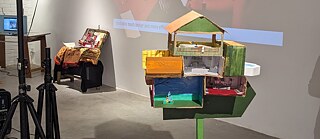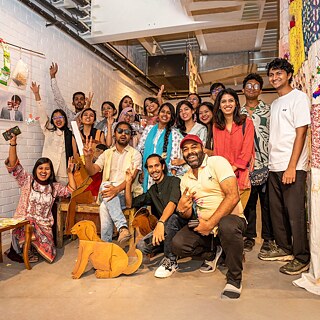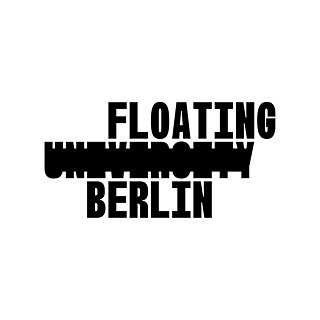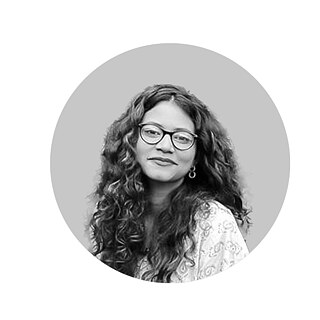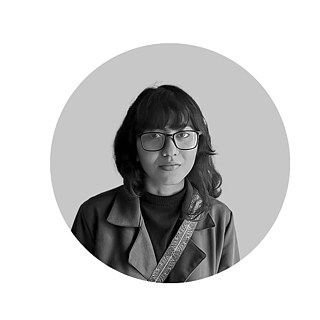Student work
The exhibition was curated by Tarannum Nibir With the support of Ruhul Abdin, Abdul Kadir.
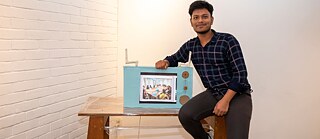
Korail Tellyverse
I thought of making something that would show not only Korail, but all the work we have done so far in Korail, where I am from. A fundamental tendency exists in all imaging devices, including television: the attempt to preserve human memory. I want to reflect that in this project. We have thousands of memories behind all the work related to Korail. So the TV is also working as an archive of the work done by us. I made a TV out of discarded cartons and plastic pipes. This TV shows our various activities with the neighborhood from 2021 up to the 2024 Winter School.
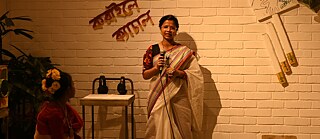
Koraile Kechal: A Journey Through Sound and Memory
"Koraile Kechal" is a project that combines the sounds of Korail with stories from my childhood. I reflect on how these sounds have shaped my childhood and continue to influence my view of the present. I explore the lasting power of the connection between sounds and memories and how this makes us feel, where we often feel that the past is better than the present. I am reading short stories based on my childhood memories, each linked to specific sounds that were important to me. Then I compared these stories and the times they represent with the present, reflecting on how things have changed.
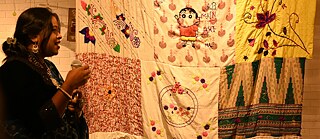
Kolpo Kanthay Korail
Old saris or cloth are sewn to create kantha, an example of our traditional craft. These kanthas reflect intricate designs and motifs inspired by the hearts and minds of the people, making each piece a work of Art. Among the residents of Korail, there is a special interest and love for these embroidered kanthas. We have friends and companions who, in their spare time, design and create these kanthas. They breathe new life into the fabric with not just their skills, but also with their talent and creativity. Each kantha they create is a manifestation of their deep feelings and creative thoughts. The motifs on the kanthas reflect the lives of the people of Korail and their hopes.
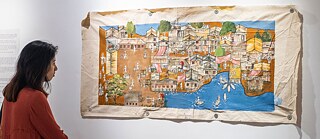
Reflection of Korail
The mural represents the diverse experiences of the youth who have grown up in Korail, capturing the essence of the community through their eyes. Each participant has contributed drawings that highlight their favorite places, some of which remain, while others exist only in memories. This is an idea of a mural that aims to create a vibrant collage drawing, showcasing the talented youth of Korail. I collaborated with young artists from the community who are passionate about drawing, sketching, and other forms of art to participate in this initiative. With the invaluable assistance of Liza, we have enlisted 10 enthusiastic youngsters (Ahsan, Hanufa, Ibrahim, Liza, Muhid, Soniya, Sumaiya, Taisir, Yeasin) who participated in this project.
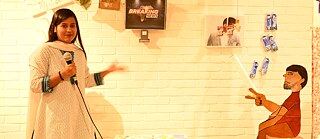
Tea stall of Korail
I am a tea shop, a small but lively place in a corner of the city. My life started very simple, but now my days are quite fun. You can also find me at Mosharraf Bazar in Korai. Every morning my owner Ramiz Bhai, sets me up—hot pots of tea, glass jars of biscuits and sweets. All kinds of people come to me - office workers, school going kids, imams from nearby mosques.Everyone comes in search of some peace in a cup of tea.I don't just give tea and breakfast, I witness the laughter and tears, stories and chats. People come to me to relieve a little, to talk about their thoughts. As the light fades after dusk, I radiate a different kind of warmth. I don't see myself just as a tea stall but also as a place which keeps different memories of Korail.

Vegetable Tales
“Shobjir Shomachar” or Vegetable Tales focuses on the creative ways that they are used in multiple facets of life by the residents of Korail based on the seasonal and local availability of the vegetables. The explorations began with artisans at Korail who at some point used vegetables to print designs on clothes. I held a workshop with Korail residents to participate in printing designs on fabric. While printing, we shared stories about how vegetables are not just consumed as food, but are central to expressions of different times in one’s life at Korail- as toys when children, as decorative elements when adolescents, and as food when adults.

Girls reclaiming public spaces
During the CADSE course, I explored Korail to understand how adolescent girls at Korail spend their time. While many boys played cricket on Ershad Maath, the only open space in Korail, no girls were present. Public spaces should be for everyone, so where are the young girls? In an alley, I met two 12-year-old girls playing with stones. They shared that they used to go to the Ershad Maath when they were younger, but recently they stopped as it is considered unsafe for girls- it is common for boys to attack girls with pieces of bricks and girls as young as 12 years old face sexual Harassment. In this backdrop, I wrote a short fiction following the story of a 15-year-old girl from Korail who, after a troubling incident, decides to reclaim Ershad Maath for herself and other girls. In a society where assertive girls are labeled negatively, can she succeed in claiming her space?
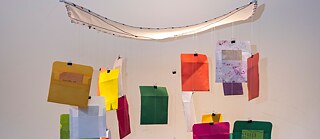
Letter Exchange in Korail
“Letter Exchange in Korail” is a community engagement and research project aimed at exploring and documenting the daily practices, beliefs, and cultural narratives of Korail residents in Dhaka through letter exchanges. This initiative fosters a personal connection, bringing out their inner emotions and stories to provide a platform for cultural exchange and mutual understanding.I wrote to 20 people of different gender and age groups who live in Korail. I went to their home, spent time with them, explained my intention and developed the project with them.
The project seeks to understand the lives of marginalized communities. Letter writing is chosen for its intimacy and ability to capture deeper, reflective insights, allowing participants to share their authentic stories and cultural practices.
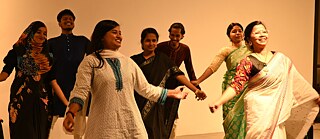
Protibhar Hoichoi
Pratibhar Hoichoi presents an archive of profiles from current and prior artists based in Korail. These artists, who are engaged in various professions including housework help, homemaking, and studies, also practice different forms of arts even in the midst of their busy schedules. You are cordially invited to a cultural program on Friday 7th June where the artistes will perform songs, dances, and mime performances.
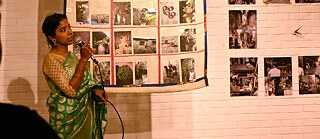
Green Desires and Hobbies
Even if there is a lack of space at Korail for residents, there are many who will still plant trees or small plants wherever they find space. While some participate in gardening out of need, some do it from a passion. I approached such residents at Korail and discovered the ways that they’ve organized and decorated their lives. I have shared a few glimpses of these expressions of aesthetic inclinations captured as images on jute fabric, a material that I personally use to make decorative elements for my own house and for my friends.
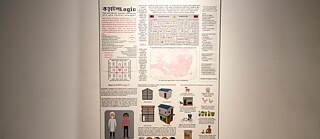
‘Korail Logic’
(the ultimate social network: Are you social enough?)
My project aims to explore the distinctive social aspects of Korail's community life that set it apart from other communities. The project comprises two parts. The first part involves findings derived from interviews, observations, data collected from the community and a review of existing literature. These insights will be presented as a visual essay, incorporating both written and graphical elements. The final outcome will be a 2D question-and-answer-based game, designed to educate players about Korail's social dynamics and demonstrate the workings of social capital within this unique community. Korail ~ A is a city within a city, governed by its own unique rules and informal settlement within the formal setting of Dhaka. The residents of Korail face constant uncertainty, with the threat of eviction looming over them. This persistent sense of vulnerability has fostered a strong sense of community and mutual reliance among the inhabitants, creating a unique social fabric characterized by trust, bonding, and civic engagement. Social capital, an essential element for their survival, is highly valued in Korail, where the power of social connections is both profound and palpable.

Korail through Bioscope
The journey began with a deep dive into the heart of Korail. Immersing myself in the vibrant chaos and colors, we spent invaluable time with the children who call Korail home. Their laughter, dreams, and resilience painted a picture far richer than the one portrayed by the outside world. My motivation stems from a desire to challenge perceptions and illuminate the untold stories of Korail. I sought to create a platform that not only showcases the raw beauty and complexity of life in Korail but also celebrates the community’s spirit. By engaging the youth in the creative process, the project transcends mere storytelling; it becomes a collaborative tapestry woven with threads of hope and unity. To ensure authenticity, I have enlisted the talents of the youth from Korail, transforming them from mere subjects of the story to its co-creators. Together, we are crafting a visual narrative that is as playful as it is poignant, ensuring that every turn of the bioscope’s crank brings forth a burst of life that is Korail.
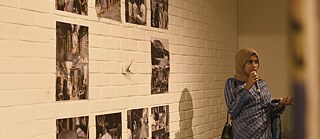
Exploring safe space for women
As the golden hour light starts to cast softer shadows, girls and women of different ages can be seen gathering around their favorite food stalls, asking the vendor to make their fuchkas extra spicy. Men-women-children flock to the lakeside to enjoy the weather, lining the edges of “Matir Rasta”.At night, gatherings are held at houses and balconies and the space outside their homes. Women have made spaces to fit their own comfort throughout this mini city. My inquisition about what a safe space for women at Korail might be like, led me to tailor shops and tea stalls with women owners, to enclosed spaces and to public open spaces. I looked at the spaces where they felt comfortable to sit and exist at different moments throughout the day.
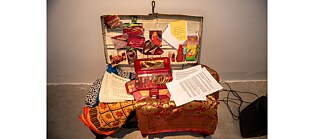
Weddings of Korail
Weddings and the festivities around it are a big part of Bangladeshi culture. This project is a culmination of the query seeking to explore how people at Korail celebrate their weddings. The trunk is a portal to the weddings at Korail, either from a collected photo from Korail residents, a new saree to be packed in the luggage that the bride will take to her in-laws, or a bottle of red alta bought at the store while I walked over to collect this old trunk from Rubina nani.
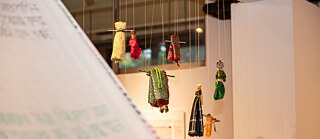
Fabric dolls of Korail
Making dolls from old scraps collected from the tailors at Boubazar used to be a regular reality for children at Korail just a few years back. The trend of handmade dolls made a dip as women became integral to the income generating economy, and family care structures changed. I collected scraps and made dolls with Korail residents, mostly the youth. While making the dolls I gathered their memories of play, which are now focused on toys that are bought from the bazaars or that they make from the scraps of pollution generated daily, some of which comes from the small packaged goods that have flushed the Korail stalls.
